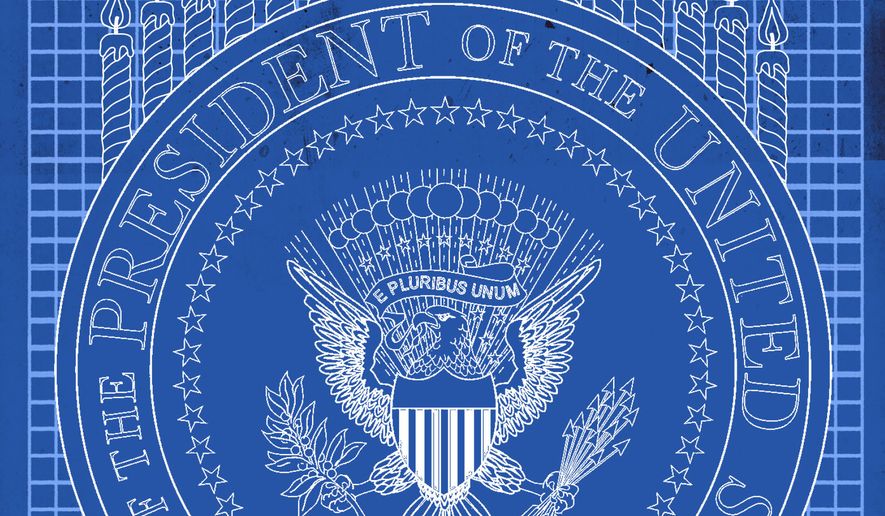OPINION:
This year marks the 80th anniversary of President Truman’s codification of a single, official design of the presidential seal. The flag that was presented for approval to Truman by George Elsey, a White House military aide and my early predecessor at the White House Historical Association, hangs proudly on the wall of my office today.
The current presidential seal is a regular element of presidential appearances and conveys the power of the American presidency. Although this beautiful seal has been consistent for more than 14 presidencies, from 1789 to World War II, presidents have shifted among variations of seal designs. The history of the seal is rich and complex, as the incredible work that goes into its production reflects the artistry and tradition of the president’s official insignia.
Given the American Founding Fathers’ aversion to any symbolism or insignia that could be construed as representative of monarchy, the constitutional republic was founded without an official seal of the president. Nevertheless, presidential seals popped up in the 1800s and have always taken inspiration from the Great Seal of the United States, adopted by the Continental Congress in 1782. The Great Seal’s characteristic outstretched eagle with an olive branch and arrows was the guide for many early iterations of a presidential seal. With a lack of legislative action codifying a particular arrangement of the seal, 19th-century presidents configured the presidential seal with their individual preferences in mind.
One of the earliest iterations of the seal emerged from President Polk’s administration (left). Polk’s successor, President Fillmore, is believed to have drawn his own design of the presidential seal in 1850. President Hayes adopted a design similar to Polk’s seal (right). The Hayes administration was the first presidency to use the presidential seal on official invitations and correspondence from the White House.
In 1902, President Theodore Roosevelt renovated the White House and ordered a new presidential seal to be installed on the floor of the White House Entrance Hall. French American sculptor Philip Martiny inlaid a bronze design resembling Hayes’ seal iteration. Notably, the Martiny plaque is the first variation of the seal to include the engraved words “Seal of the President of the United States” around its design.
Roosevelt’s seal was the norm for the next two decades, until President Wilson adapted the seal into a new model of the presidential American flag. Characterized by its deep blue color and four stars in the corner of the flag, this symbol of the presidency endured until well into World War II.
President Franklin D. Roosevelt, an assistant secretary of the Navy in the Wilson administration, held a deep interest in military insignia and heraldry. In 1945, he asked Elsey, a White House naval officer, to redesign the presidential flag and seal. Elsey consulted with Army Chief of Heraldry Arthur DuBois to create the design with the characteristic eagle facing the olive branch and 48 stars surrounding the eagle.
Although Roosevelt did not live to see the new presidential seal, Truman codified into law this iteration as the official seal of the president in 1945 through an executive order. Redesigned in 1959 and 1960 to add stars recognizing Hawaiian and Alaskan statehood, the 1945 seal design has endured to this day as the universally recognized seal of the president.
Since 1919, during the Wilson administration, the U.S. Army has included a wing dedicated specifically to military heraldry. The Heraldic Program Office was created primarily to service the demand for military awards and insignia after World War I. To help meet growing demand, the Army restructured the Heraldic Program in 1960 into the Institute of Heraldry, its present-day organizational structure.
Located at Fort Belvoir in Virginia, the Institute of Heraldry still works primarily with military insignia and awards. It also sponsors the creation of the official Seal of the President of the United States. With the ability to cast 8- to 25-inch seals, the institute’s master production staff handcrafts each seal to meet White House needs. The presidential seal is set in a plaster mold for 24 hours before being hand-painted by Heraldry staff.
Today, the Institute of Heraldry’s important work goes wherever the president goes. Whether working in the Oval Office, traveling on Air Force One or in limousines, or delivering speeches, the presidential seal follows the president. The history of the seal reveals how American symbols change and evolve over time and gradually become revered and admired accordingly.
• Stewart McLaurin is president of the White House Historical Association.




Please read our comment policy before commenting.